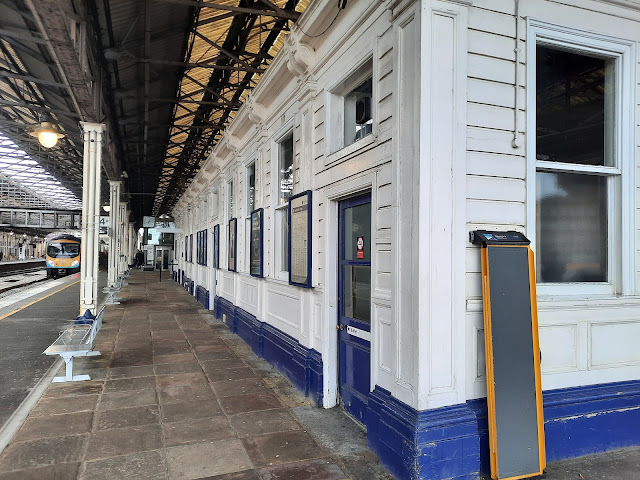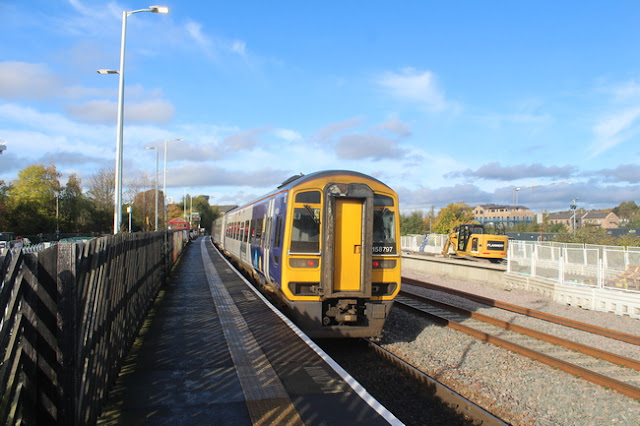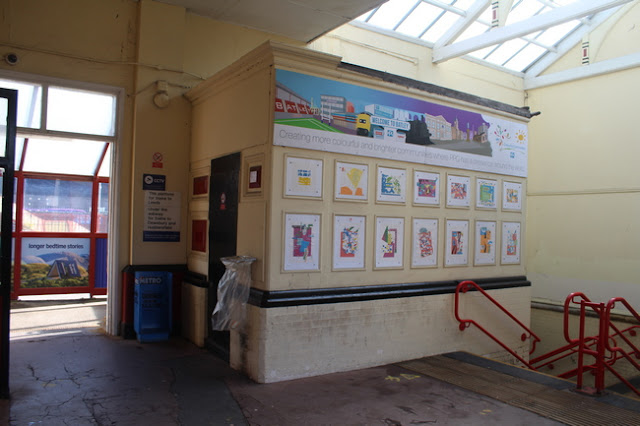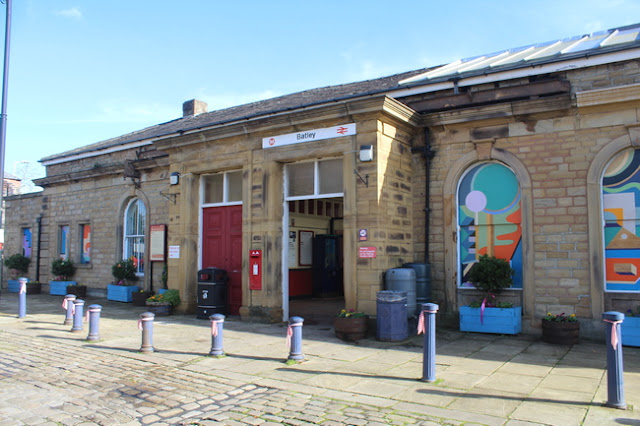Journeys by train between Huddersfield and Leeds looking at the changes taking place to the route.
Rail Map Online
Up to the 1990s the rail route between Leeds and Huddersfield has seen rationalisation that has meant the loss of four track sections and the simplification of the flying junction at Heaton Lodge that had itself only been created following the closure of the duplicate Leeds New Line route in the 1960s. Since the 1990s the frequency of services on the route has increased creating what is now quite a bottleneck. Work is now underway to reinstate the four track sections between Huddersfield and Dewsbury, complete with flying junctions at Heaton Lodge and Thornhill that will allow fast trains to pass on the main Transpennine route without conflicting with stopping trains and freight trains on the diverging routes to Wakefield and to the Calder Valley. The work will also see the route electrified between York and Manchester. I have recently stopped off along the route photographing the changes taking place.
Huddersfield
1932 Map
Below - The grand station entrance to Huddersfield station.
Below - A scene dominated by Northern class 150s from the local stopping services. The unit stabled in the sidings on the right is something that will not be seen for long as extra platforms are built at the site of the sidings and new sidings are built to the east of Huddersfield to replace them. Note the large former goods shed and wagon hoist in the background.
Below - The former station buffet and waiting room has disappeared since I took these shots. Fortunately it should be reinstated in the expanded station after being restored off site.
Deighton
Deighton station was originally situated on the Kirkburton branch just east of Kirkburton Junction, the original station closed in 1930. A new Deighton station opened in 1982 on the main line at the site of the junction.
The current station at Deighton will be replaced with a completely new one on the two slow lines as the four track formation is reinstated. This is involving excavation to the north of the existing two tracks due to industrial units having been built on the south side of the track since the route previously had four tracks.
Mirfield
Below - Back in 2008 a steam special passing Mirfield crosses the River Calder. It can be seen how the bridge originally had two tracks but was was widened to four. The bridge nearest me only carries one track at present, the one through Platform 3 at Mirfield station. With the upgrade work it will carry the two fast tracks on the nearer bridge and the two slow tracks on the earlier bridge behind it.
The original station was an island platform with bays in between the through lines. When Heaton Lodge Junction between Deighton was simplified in the early 1990s the lines through Mirfield were reduced from four to three tracks and a third platform was added to the south of the original station so that expresses could only pass stoppers heading west (heading east the passing place was through Dewsbury station). The stoppers would stop at Platform 3 while very few services stopped at the westbound platform 2 on the original station.
After the upgrade all stopping services will revert to the original island platform and the fast tracks will pass to the south of the station. Platform 3 will be removed but a new footbridge with lifts will provide access to the car park at that side of the station.
Below - A stopper for Wigan (turning off the main line at Heaton Lodge and going via the Calder Valley line) at the current platform 3 while work to extend platforms 1 and 2 for longer trains can be seen on the right.
Below - Looking towards Leeds from Platform 3.
Below - The current step access to platforms 1 and 2 from the road beneath the station. A new larger entrance with lifts will be built on the other side of the road behind me here.
Below - A Grand Central service to London Kings Cross on Platform 1. That train will turn off the mainline at Thornhill LNWR Junction to head to Wakefield. At present trains in both directions on the busier Huddersfield route would have to stop while it crosses the junction but in future the fast lines will cross over the junction on a new flyover.
Below - A TPE service on Platform 3.
Ravensthorpe
This station is situated next to Thornhill LNWR Junction, the lines towards Wakefield pass to the south of the platforms. The station will be replaced with a new one to the west of the current site as a flyover will be constructed here taking the fast lines over the top of the junction. The new location of the station will allow trains heading in the Leeds and Wakefield directions to stop at Ravensthorpe.
Below - Looking from the footbridge at Ravensthorpe station towards Huddersfield, this is Thornhill LNWR Junction and just beyond the junction will be the site of the new station. Work can be seen going on at the site as a freight train from Drax power station to Liverpool passes. Again any trains on the main Leeds to Huddersfield route would have to stop for it to pass but in future they will pass be on the fast lines while it uses the separate slow lines.
Below - A TPE train heading west through Ravensthorpe.
Below - Closure notice for Ravensthorpe station on display at Leeds station.
Dewsbury
Below - The main entrance to Dewsbury station.
With the two major junctions past the line will revert to two tracks at Dewsbury before crossing a couple of viaducts before Batley followed by the Morley tunnel, features that would make widening impossible here. (though this was why the Victorian railway companies built the Leeds New Line route which was lost in the Beeching cuts)
Batley
Batley is an unstaffed station but still retains part of its station building at the entrance as it contains the access to the subway between platforms. Originally there were effectively two stations
Morley
Morley has already had its station replaced with a new one to the east of the original station. This has allowed the footbridge to be replaced with one with lifts and extra height to allow room for the overhead wires. The alignment of the track has also been altered to increase the speed limit.
Below - Remains of the old station.
White Rose
A new station will replace Cottingley station situated 750m to the east as well as within walking distance of the White Rose shopping centre and office complex.
Below - The future White Rose station. Though mostly complete work has stalled on the station due to escalating costs (no doubt that will in itself escalate the costs considerably). Work was supposed to restart around the time of my visit. Note the masts for the overhead wires having been installed.
Cottingley
Cottingley station opened in 1988 to serve the Cottingley and Churwell areas, it should close when the White Rose station opens.
Below - With half the Leeds to Huddersfield stopping services now back under Northern Rail operation a 3 car 150 stops at Cottingley.
Below - A pair of TPE Class 185 units passing Cottingley, note the masts for the electrification.
Below - The station entrance at Cottingley. Being a modern station it has never had station buildings, just a footbridge and waiting shelters on the wooden platforms.
Below - Looking towards Huddersfield from Cottingley, the new masts can be seen.
Below - Transpennine Express still run half the stopping services, including this one to Leeds.
Farnley and Wortley
Not a part of the Transpennine route upgrade plans as this station closed in 1952. I thought I'd mention it as trains still pass the site, and it is within walking distance from where I live. Originally the platforms where on what is now the main line in to Leeds, though when the route in to Leeds via the Holbeck viaduct was opened in 1882 new platforms were built on that route and a footbridge built over the original station site to access the new one. The Holbeck viaduct line was later cut back to connect instead with the Doncaster line (a big planning mistake as had the Holbeck viaduct line continued to serve the Huddersfield line it would mean trains using the platforms now numbered 15 to 17 wouldn't have to cross other traffic through the station approach. With traffic to and from the Doncaster direction using what are now platforms 6 to 11 it's hard to see why this change was made).
Below - Station building from the original Farnley and Wortley station. The footbridge to the later station was at the far end, though a later extension to the building has been added there.
Below - A remarkable survivor is the station's original wooden goods shed.
Below - The station site seen from Dragon Bridge. The later station site and line to Leeds via the Holbeck Viaduct was on the left, an industrial building now occupying the site. A small piece of the original platform can be seen next to the station building. Also note on the left one of the new electrification masts.






































No comments:
Post a Comment